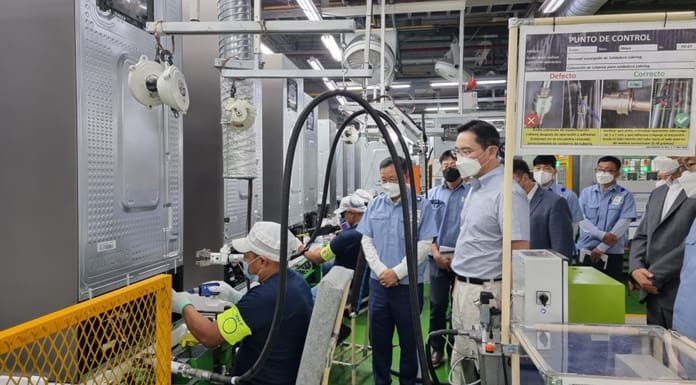Have you ever wondered Where are Samsung TVs Made? What if I told you that your state-of-the-art Samsung TV wasn’t made in South Korea, but assembled by low-paid workers in factories across the developing world? Surprising but true, Samsung outsources production of their global TV lineup to countries like Vietnam, India, and Brazil to benefit from cheaper labor costs.
In this article, I will lift the curtain on Samsung’s vast global supply chain. I’ll cover all Samsung TV locations. Also, I’ll answer some frequently asked questions about Samsung TVs to help you out. You should know, where are Samsung Phones made.
Where are Samsung TVs Made in the World?
Samsung TVs are made in a variety of locations around the world, reflecting the company’s global reach and strategy. Here’s a summary of the key locations where Samsung TVs are made.
Vietnam

Samsung’s expansion in Vietnam is a strategic move, with several factories in Thayinguen dedicated to TV production. These factories are essential for supplying TVs and Samsung Appliances to other Asian markets, including China, India, and Malaysia.
Vietnam’s choice as a manufacturing hub is made possible by low labor costs and flexible government policies. This strategic location allows Samsung to efficiently serve the growing Asian market while keeping production costs competitive.
Slovakia

In Galanta, Slovakia, Samsung has established a significant manufacturing presence. This factory is a key player in producing a broad range of Samsung TVs, particularly for the European market.
The Slovakian factory’s role is critical in ensuring Samsung maintains a strong presence in Europe, with high standards of quality control and innovation matching the company’s global reputation.
Mexico

The Tijuana factory in Mexico is one of Samsung’s largest TV production facilities, serving the North American market. This factory’s role is crucial in ensuring Samsung’s TVs continue to be a popular choice in North America.
The Mexican factory is not only significant for its production capacity but also for its strategic location. This allows Samsung to efficiently respond to North American demands.
Thailand and Brazil

Samsung’s manufacturing facilities in Thailand and Brazil play a key role in the company’s global production network. These facilities are ideally located to serve the local and regional markets.
This contributes significantly to Samsung’s ability to provide a wide range of TV models to diverse consumer bases. The presence in these countries shows Samsung’s commitment to global expansion and ability to adapt to different market needs.
Hungary

The Jasfensaru factory in Hungary is a major part of Samsung’s European manufacturing network. This facility produces a lot of TVs for the European market, in addition to the Slovakian plant.
The Hungarian factory’s role is essential in ensuring a steady supply of Samsung TVs across Europe. This is essential in maintaining the brand’s presence and meeting diverse consumer demands.
South Korea

Although Samsung shut down its only TV factory in South Korea in 2018, the country remains essential for design and planning. South Korea, being Samsung’s headquarters, plays a crucial role in the development and design of Samsung TVs.
This shift signifies Samsung’s strategic move to remain competitive in the global market while leveraging its home base for innovative design and development.
China

Samsung used to manufacture its TVs in the Chinese city of Tianjin. However, with staff salaries on the rise in China, Samsung started considering halting television production there.
By 2020, the company had closed its sole TV manufacturing plant in Tianjin. As of now, Samsung no longer makes TVs in China at all. While some key components for televisions are still produced in China and Vietnam, other parts come from various countries. Samsung TVs can be assembled in many locations across the world.
India

Samsung’s production in Chennai, India, went through changes due to increased taxation on imported TV parts in 2018. However, the lifting of some duties allowed Samsung to establish its manufacturing facility in India.
This factory is geared towards meeting the demands of the Indian and other Asian markets. This illustrates Samsung’s responsiveness to local market conditions and commitment to maintaining a strong presence in the region.
Egypt

Samsung’s factory in Beni Suef, Egypt, is a landmark in the company’s expansion into the Middle East and Africa. Established in 2013, this factory specializes in producing modern QLED TVs, catering to local markets in Africa and the Middle East.
Samsung’s commitment to emerging markets, with high-quality TVs tailored to local tastes, is highlighted by this location.
South Africa

Samsung’s establishment of a TV factory in South Africa’s Dube TradePort in 2018 marked a significant expansion on the African continent. This factory in KwaZulu-Natal province is designed to produce 5,000 units per day, to meet Samsung TV demand in Africa.
With this investment, Samsung is showing its dedication to the African market and its strategy to meet the unique needs and preferences of Africans.
Pakistan

The recent inauguration of Samsung’s latest manufacturing facility in Karachi, Pakistan, represents Samsung’s ongoing efforts to meet global demand for its TVs.
This factory, with a production target of 50,000 TVs annually, proves Samsung’s commitment to the Asian market. Samsung’s ability to supply TVs to various Asian countries will be enhanced by this facility, which is not only good for Pakistan, but also for Samsung.
Is Samsung TV manufactured in India?
Yes, Samsung TVs are manufactured in India.
Is Samsung TV a Chinese company?
No, Samsung is a South Korean company.
Which country made Samsung LED?
Samsung LEDs are manufactured in South Korea and China.
I mentioned all of the factory locations – Where are Samsung TVs Made and where are they designed? Samsung’s extensive global production network demonstrates its position as a leading technology company.
Factory locations in Vietnam, Slovakia, Mexico, Brazil, and elsewhere enable Samsung to efficiently supply quality televisions customized for diverse regional markets. While South Korea remains vital for design, Vietnam and Slovakia are important for manufacturing.